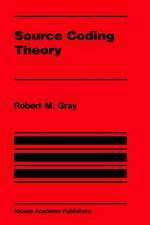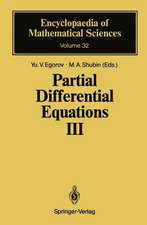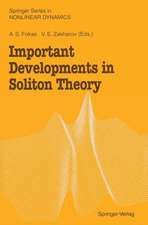Fourier Transforms: An Introduction for Engineers: The Springer International Series in Engineering and Computer Science, cartea 322
Autor Robert M. Gray, Joseph W. Goodmanen Limba Engleză Paperback – 21 oct 2012
| Toate formatele și edițiile | Preț | Express |
|---|---|---|
| Paperback (1) | 725.40 lei 6-8 săpt. | |
| Springer Us – 21 oct 2012 | 725.40 lei 6-8 săpt. | |
| Hardback (1) | 729.04 lei 6-8 săpt. | |
| Springer Us – 30 iun 1995 | 729.04 lei 6-8 săpt. |
Din seria The Springer International Series in Engineering and Computer Science
-
 Preț: 119.98 lei
Preț: 119.98 lei - 24%
 Preț: 1041.97 lei
Preț: 1041.97 lei - 20%
 Preț: 422.81 lei
Preț: 422.81 lei -
 Preț: 206.36 lei
Preț: 206.36 lei - 20%
 Preț: 313.26 lei
Preț: 313.26 lei - 20%
 Preț: 638.76 lei
Preț: 638.76 lei - 23%
 Preț: 687.70 lei
Preț: 687.70 lei - 18%
 Preț: 1216.57 lei
Preț: 1216.57 lei - 18%
 Preț: 957.92 lei
Preț: 957.92 lei - 20%
 Preț: 641.36 lei
Preț: 641.36 lei - 18%
 Preț: 941.79 lei
Preț: 941.79 lei - 20%
 Preț: 641.87 lei
Preț: 641.87 lei - 15%
 Preț: 632.77 lei
Preț: 632.77 lei - 20%
 Preț: 639.09 lei
Preț: 639.09 lei - 18%
 Preț: 942.24 lei
Preț: 942.24 lei - 20%
 Preț: 639.72 lei
Preț: 639.72 lei - 20%
 Preț: 987.57 lei
Preț: 987.57 lei - 20%
 Preț: 641.21 lei
Preț: 641.21 lei - 18%
 Preț: 939.89 lei
Preț: 939.89 lei - 20%
 Preț: 988.23 lei
Preț: 988.23 lei - 18%
 Preț: 949.94 lei
Preț: 949.94 lei - 20%
 Preț: 640.23 lei
Preț: 640.23 lei - 15%
 Preț: 644.75 lei
Preț: 644.75 lei - 18%
 Preț: 943.20 lei
Preț: 943.20 lei - 18%
 Preț: 1212.36 lei
Preț: 1212.36 lei - 18%
 Preț: 950.57 lei
Preț: 950.57 lei - 15%
 Preț: 639.24 lei
Preț: 639.24 lei - 18%
 Preț: 941.47 lei
Preț: 941.47 lei - 18%
 Preț: 940.38 lei
Preț: 940.38 lei - 20%
 Preț: 1275.16 lei
Preț: 1275.16 lei
Preț: 725.40 lei
Preț vechi: 884.64 lei
-18% Nou
Puncte Express: 1088
Preț estimativ în valută:
138.93€ • 143.14$ • 116.38£
138.93€ • 143.14$ • 116.38£
Carte tipărită la comandă
Livrare economică 24 februarie-10 martie
Preluare comenzi: 021 569.72.76
Specificații
ISBN-13: 9781461360018
ISBN-10: 1461360013
Pagini: 384
Ilustrații: XX, 361 p.
Dimensiuni: 155 x 235 x 20 mm
Greutate: 0.54 kg
Ediția:Softcover reprint of the original 1st ed. 1995
Editura: Springer Us
Colecția Springer
Seria The Springer International Series in Engineering and Computer Science
Locul publicării:New York, NY, United States
ISBN-10: 1461360013
Pagini: 384
Ilustrații: XX, 361 p.
Dimensiuni: 155 x 235 x 20 mm
Greutate: 0.54 kg
Ediția:Softcover reprint of the original 1st ed. 1995
Editura: Springer Us
Colecția Springer
Seria The Springer International Series in Engineering and Computer Science
Locul publicării:New York, NY, United States
Public țintă
ResearchCuprins
1 Signals and Systems.- 1.1 Waveforms and Sequences.- 1.2 Basic Signal Examples.- 1.3 Random Signals.- 1.4 Systems.- 1.5 Linear Combinations.- 1.6 Shifts.- 1.7 Two-Dimensional Signals.- 1.8 Sampling, Windowing, and Extending.- 1.9 Probability Functions.- 1.10 Problems.- 2 The Fourier Transform.- 2.1 Basic Definitions.- 2.2 Simple Examples.- 2.3 Cousins of the Fourier Transform.- 2.4 Multidimensional Transforms.- 2.5 * The DFT Approximation to the CTFT.- 2.6 The Fast Fourier Transform.- 2.7 * Existence Conditions.- 2.8 Problems.- 3 Fourier Inversion.- 3.1 Inverting the DFT.- 3.2 Discrete Time Fourier Series.- 3.3 Inverting the Infinite Duration DTFT.- 3.4 Inverting the CTFT.- 3.5 Continuous Time Fourier Series.- 3.6 Duality.- 3.7 Summary.- 3.8 * Orthonormal Bases.- 3.9 * Discrete Time Wavelet Transforms.- 3.10 * Two-Dimensional Inversion.- 3.11 Problems.- 4 Basic Properties.- 4.1 Linearity.- 4.2 Shifts.- 4.3 Modulation.- 4.4 Parseval’s Theorem.- 4.5 The Sampling Theorem.- 4.6 The DTFT of a Sampled Signal.- 4.7 * Pulse Amplitude Modulation (PAM).- 4.8 The Stretch Theorem.- 4.9 * Downsampling.- 4.10 * Upsampling.- 4.11 The Derivative and Difference Theorems.- 4.12 Moment Generating.- 4.13 Bandwidth and Pulse Width.- 4.14 Symmetry Properties.- 4.15 Problems.- 5 Generalized Transforms and Functions.- 5.1 Limiting Transforms.- 5.2 Periodic Signals and Fourier Series.- 5.3 Generalized Functions.- 5.4 Fourier Transforms of Generalized Functions.- 5.5 * Derivatives of Delta Functions.- 5.6 * The Generalized Function ?(g(t)).- 5.7 Impulse Trains.- 5.8 Problems.- 6 Convolution and Correlation.- 6.1 Linear Systems and Convolution.- 6.2 Convolution.- 6.3 Examples of Convolution.- 6.4 The Convolution Theorem.- 6.5 Fourier Analysis of Linear Systems.- 6.6 The Integral Theorem.- 6.7Sampling Revisited.- 6.8 Correlation.- 6.9 Parseval’s Theorem Revisited.- 6.10 * Bandwidth and Pulsewidth Revisited.- 6.11 * The Central Limit Theorem.- 6.12 Problems.- 7 Two Dimensional Fourier Analysis.- 7.1 Properties of 2-D Fourier Transforms.- 7.2 Two Dimensional Linear Systems.- 7.3 Reconstruction from Projections.- 7.4 The Inversion Problem.- 7.5 Examples of the Projection-Slice Theorem.- 7.6 Reconstruction.- 7.7 * Two-Dimensional Sampling Theory.- 7.8 Problems.- 8 Memoryless Nonlinearities.- 8.1 Memoryless Nonlinearities.- 8.2 Sinusoidal Inputs.- 8.3 Phase Modulation.- 8.4 Uniform Quantization.- 8.5 Problems.- A Fourier Transform Tables.















